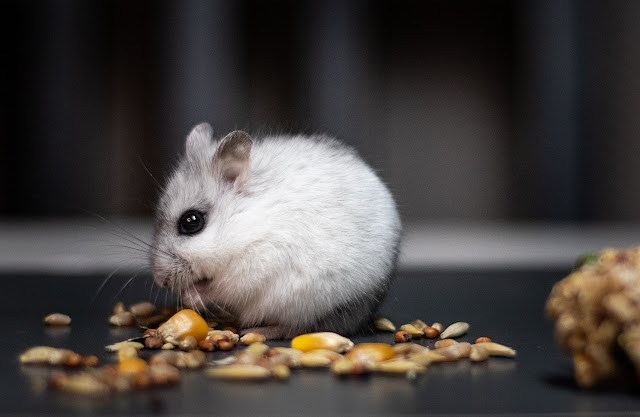Dwarf hamsters are pocket pets that can be cared for by people of all ages. These small animals come from the deserts and steppes of Mongolia and Siberia. They require a special diet because they do not produce enough amylase, an enzyme that breaks starch down into sugar. This means they will get little energy from foods like grains and vegetables.
1. Commercial Food
Dwarf hamsters are omnivores, which means they eat both plant and animal material. Most commonly, commercial foods are made of seed mixtures with dried fruits, nuts/seeds, soybeans, or sweeteners added to make them more palatable. The protein content in these commercial foods is usually 9-15%, the fat content 2-9%, and the fiber 1-3%.
Some hamster owners give their hamsters a combination of seed and pellet mixtures, while others choose one type over the other.
Commercial diets should always be supplemented with fresh fruits, vegetables, whole grains (bread, pasta), legumes (beans, peas), and/or meat.
2. Pellets
Pelleted diets for hamsters consist of a grain base (wheat, corn, oats), with added protein sources such as soybean meal, dried milk, or egg, and a vitamin/mineral premix containing the elements necessary to properly nutrition dwarf hamsters. The protein content of these diets is usually 15-20%, with fat content between 5-14%.
Pelleted diets are always supplemented with fresh fruits, vegetables, whole grains (bread, pasta), legumes (beans, peas), and/or meat.
Since pellets are made from grains, they become sticky when wet and somewhat difficult to handle. Pelleted diets are usually sold in small pre-measured amounts that are either stapled together or are packaged with a plastic zip-lock cover. This style of packaging makes it impossible to reclose the package once opened, so owners must be careful not to overfeed their hamsters.
3. Seed Mixtures
Seed mixtures for hamsters consist of a base (wheat, oats), supplemented with protein sources such as sunflower seeds, peanuts, soybeans, and dried milk proteins, and a vitamin/mineral premix containing the elements necessary to properly nutrition dwarf hamsters. The protein content of these diets is usually 10-12%, with fat content between 9-14%.
Seed mixtures are always supplemented with fresh fruits, vegetables, whole grains (bread, pasta), legumes (beans, peas), and/or meat.
Since seed mixtures tend to be moist in nature they can generally be left out for an extended period of time without concern for spoilage and can be fed as a meal by meal replacement.
4. Occasional Treats
Occasional treats for dwarf hamsters include:
- Bread and baked goods (cookies, cakes, etc.) - Breakfast cereals (Froot Loops, Cocoa Puffs, Kashi) - Cakes and other desserts (jello, pudding) - Fruits and vegetables (bananas, apples, carrots) - Nuts and seeds (almonds, peanuts, sunflower seeds) - Yogurt drops or yogurt covered raisins
Treats should make up no more than 5-10% of a hamster's diet. An excess amount of treats can cause obesity in dwarf hamsters.
5. Fresh Foods
Fresh foods for dwarf hamsters include:
- Bread and baked goods (cookies, cakes, etc.) - Cereals (oatmeal) - Cakes and other desserts (jello, pudding) - Fruits and vegetables (bananas, apples, carrots) - Nuts and seeds (almonds, peanuts, sunflower seeds) - Yogurt drops or yogurt covered raisins
Fresh foods should make up no more than 5-10% of a hamster's diet. An excess amount of fresh foods can cause diarrhea in dwarf hamsters.
6. Meat & Dairy Products
Dwarf hamsters are not dependent on a diet that includes meat but will eat small amounts of meat if offered as a treat.
Dairy products such as cheese and yogurt should not be given to dwarf hamsters because many species are lactose intolerant.
Fruits and vegetables do not have to be fresh or washed prior to being fed as treats, however, all foods should be washed and scrubbed prior to being given as a main portion of the diet.
Conclusion
Determining the nutritional needs of your hamster cannot be done simply by looking at the food label on its cage or at ingredients that go into making it. You must understand how to read those labels, as well as study the nutritional values of commercially available fruits, vegetables, grains, and meats.
Once you have a good understanding of those things, then you can determine what mixture will best meet your pet's dietary needs.


